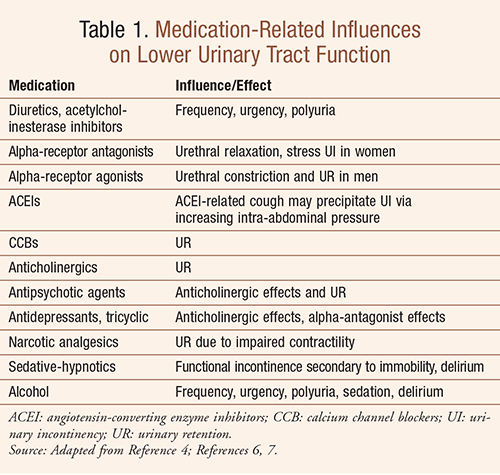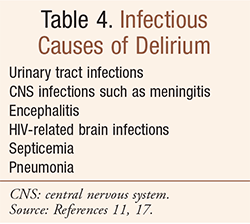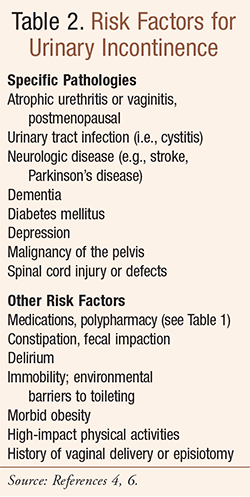Life expectancy is increasing. A healthy senior at age 65 years is expected to live 18 more years; those healthy at 85 years, 8 more.1 It is not difficult to understand why today’s seniors and their caregivers are actively seeking available treatment options in many areas of healthcare to improve their quality of life. With regard to urologic conditions, over 60% of a urologist’s outpatient practice is devoted to caring for individuals older than 65 years, and more than 50% of urologic surgery is performed on patients more than 65 years of age.1 The fast-growing geriatric population has presented unique challenges in urologic practice and has led to the development of the field of geriatric urology as an identified subspecialty. This article will focus on urinary incontinence and medication-related influences on the function of the lower urinary tract—urologic issues that are common in seniors—and touch briefly on delirium as a noteworthy nuance of the clinical presentation of urinary tract infection (UTI) in older adults. The collaborative approach to care of the geriatric patient will also be emphasized.
Urinary Incontinence
Continence—the ability to retain the contents of the bladder until it is appropriate to urinate—requires capabilities in both the physiological (functional nervous system, intact bladder and urethral function) and cognitive (ability to react to bladder urges, motivation to be continent) domains. A disruption in any of these capabilities can result in the inability to attain or maintain continence. Urinary incontinence (UI), an involuntary leakage of urine, is a common condition affecting more than 50% of women over the age of 70 years.2,3 While it is possible to differentiate bladder overactivity or urge incontinence (e.g., nocturia: waking to pass urine at night; nocturnal incontinence: wet pads or undergarments in bed) from urethral underactivity or stress incontinence (e.g., leaking during physical activity: coughing, sneezing, lifting; ability to reach toilet in time following an urge to void), both conditions may coexist; this is termed mixed incontinence.4 Mixed incontinence occurs most commonly in elderly patients, especially older women.5,6
Patients presenting with a complaint of UI require a workup, ideally including an abdominal examination to exclude an extended bladder, a brief neurologic assessment of the perineum and lower extremities, a pelvic examination in women to check for prolapse or hormonal deficiency, and a genital and prostate examination in men.4 When evaluating UI in the elderly, particularly in those seniors with comorbidities and complex medication regimens, drug-induced or drug-aggravated etiologies must be ruled out. TABLE 1 can assist pharmacists in identifying potential medication-related influences on lower urinary tract function, and TABLE 2 presents risk factors for UI. Pharmacotherapy plan recommendations can address and collaboratively assist with the resolution and prevention of these often troublesome and complicating influences.

Of note, nonpharmacologic, nonsurgical therapy is considered the foundation of management of several types of UI; these interventions should often be the first therapy, initiated and then continued even when medication therapy for UI is begun. For an extensive table of nonpharmacologic management of UI, see Resources. If tailored therapeutic goals for a patient are not achieved with optimal dosing (see Reference 4), the addition of a second agent or the switch to an alternative agent should be considered.4 Considerations influencing choice of therapy for UI can be found in TABLE 3, and specific geriatric dosing guidelines may be found in Reference 7.

Pharmacist as Collaborator
Maintenance of independence and prevention of disability are primary goals in the clinical care of persons 65 years of age and older.8 Despite the benefits of pharmacotherapy, a senior’s health-related quality of life may be compromised by medication-related problems. As often occurs with a functional decline, medications may be initiated to target associated symptomatology (e.g., UI) before nonpharmacologic modalities have been maximized. Furthermore, the alteration of function may in fact have occurred secondary to medication (TABLE 1) already in the patient’s medication regimen. Therefore, it is vital to obtain an accurate and thorough medication history and specific medical historical information when interviewing a patient and his or her caregiver.
Moreover, preventing medication-related adverse consequences in seniors requires that pharmacists be knowledgeable about age-specific issues related to pharmacokinetics and pharmacodynamics that determine the appropriateness of a particular pharmaceutical agent for an individual patient; guide proper dosing; and help other healthcare clinicians with nuances of therapy in the geriatric population. Since the needs of senior patients differ dramatically from those of younger adults, a collaborative approach to care can result in the use of novel strategies that have been developed and refined through years of clinical experience in working with seniors.
Collaboration is the key to truly comprehensive, highly coordinated care. Collaboration, for example, among the patient’s geriatrician, primary care physician, urologist, pharmacist, and other specialists, is suggested.9 Additionally, comprehensive geriatric assessment enhances the approach to reducing medication-related problems.10 When pharmacists have access to patients during medication management, prescription counseling, consultant medication regimen reviews, or medication reconciliation, a careful assessment can help discern a reversible and physical cause of mental status changes. For example, in some cases of UI, there may be an absence of bothersome symptoms, such as frequency, urgency, or burning, with just the simple presence of bacteria (e.g., white blood count <105 colonies per mL); in this case observation without treatment with antibiotics is sometimes an option.3 Presentation of atypical symptoms, such as confusion, changes in mental status, lack of appetite, or nausea, should be taken seriously in association with the presence of bacteria in the urine, and active treatment should be implemented.3 Pharmacists can refer patients for medical evaluation and intervention to prevent the downward progression of physical and cognitive symptoms.
UTIs and Delirium
Caregivers should be made aware that confusion, and possibly delirium, are considered atypical signs of UTIs and other potential infections (TABLE 4) and require immediate medical attention. Delirium is defined as a transient, usually reversible cause of cerebral dysfunction; it manifests clinically with a wide range of neuropsychiatric abnormalities.11 While delirium can occur at any age, it occurs more commonly in the elderly and in those who have compromised mental status.11 Furthermore, approximately 40% of delirium cases are caused by medications (TABLE 5).12 Delirium has been shown to be present in 10% to 22% of elderly patients at the time of hospital admission, with an additional 10% to 30% of cases developing after admission; it is extremely common among nursing home residents.11 Of note, even medications at therapeutic doses and levels can cause delirium in the elderly.11

Mortality rates are 10% to 26% in patients who are admitted with delirium, and patients who develop delirium during hospitalization have a mortality rate of 22% to 76% and a high rate of death during the months following discharge.13,14 In the elderly and those patients in the postoperative period, a prolonged hospital stay may follow delirium and increase complications, cost, and long-term disability.15
Conclusion
Accurate and thorough medication history and specific medical historical information prove vital to the process of appropriate pharmacotherapy planning for senior patients with urinary incontinence. Pharmacists as collaborators can identify medication etiologies of UI, provide therapeutic recommendations, raise awareness of these issues, and provide appropriate caregiver guidance. Pharmacists can refer patients with atypical UTI symptoms such as confusion and delirium to prevent further physical and cognitive deterioration. Importantly, pharmacists should be ever aware that patient-specific treatment goals are not static declarations, but rather may change over time and need to be reassessed on a regular basis so as not to overlook opportunities to eliminate potential drug-induced or drug-aggravated etiologies.
REFERENCES
1. Basler
J, Glazier E, Payne B. 2009 Geriatric Urology Symposium. University of Texas Health Science Center at San Antonio, School of Medicine. http://urology.uthscsa.edu/Files/Symposium/2009/Glazier Introduction.pdf. Accessed July 8, 2014.
2. Abrams P, Cardoza L, Fall M, et al. The standardization of terminology of lower urinary tract function: report from the standardization subcommittee of the International Continence Society. Neurourol Urodyn. 2002;21:167-178.
3. Daneshgari F. Geriatric urology. MD News. November 04, 2011. www.mdnews.com/news/2011_11/05737_novdec2011_geriatric-urology.aspx. Accessed July 8, 2014.
4. Rovner ES, Wyman J, Lackner T, Guay DR. Urinary incontinence. In: DiPiro JT, Talbert RL, Yee GC, et al, eds. Pharmacotherapy: A Pathophysiologic Approach. 8th ed. New York, NY: McGraw-Hill Inc; 2011:1467-1485.
5. Resnick NM, Yalla S. Detrusor hyperactivity with impaired contractile function. An unrecognized but common cause of incontinence in the elderly patient. JAMA. 1987;257:3076-3081.
6. Brandt CL, Emerson RJ. Disorders of the lower urinary tract. In: Copstead LE, Banasik J. Pathophysiology. 5th ed. St. Louis, MO: Elsevier Saunders; 2013:610-613.
7. Semla TP, Beizer JL, Higbee MD. Geriatric Dosage Handbook. 19th ed. Hudson, OH: Lexicomp; 2014.
8. Hajjar ER, Gray SL, Guay DR, et al. Geriatrics. In: DiPiro JT, Talbert RL, Yee GC, et al, eds. Pharmacotherapy: A Pathophysiologic Approach. 8th ed. New York, NY: McGraw-Hill Inc; 2011. http://accesspharmacy.mhmedical.com/content.aspx?bookid=462§ionid=41100777. Accessed July 8, 2014.
9. Mass General Hospital. Department of Urology, Geriatric Urology Program. Our approach. www.massgeneral.org/urology/services/treatmentprograms.aspx?id=1377. Accessed July 8, 2014.
10. Zagaria ME. Geriatric emergency department care: the pharmacist’s role. US Pharm. 2014;39(5):18-21.
11. Alagiakrishnan K. Delirium. Medscape.com. Updated April 28, 2014. http://emedicine.medscape.com/article/288890-followup#showall. Accessed July 14, 2014.
12. Demeure MJ, Fain MJ. The elderly surgical patient and postoperative delirium. J Am Coll Surg. 2006;203:752-757.
13. McCusker J, Cole M, Abrahamowicz M, et al.Delirium predicts 12-month mortality. Arch Intern Med. 2002;162(4):457-463.
14. American Psychiatric Association. Practice guideline for the treatment of patients with delirium. Am J Psychiatry. 1999;156(5 suppl):1-20.
15. Marcantonio ER, Kiely DK, Simon SE, et al. Outcomes of older people admitted to postacute facilities with delirium. J Am Geriatr Soc. 2005;53:963-969.
16. Delirium. The Merck Manual Home Health Handbook for Patients & Caregivers. Last full review/revision July 2013. www.merckmanuals.com/home/brain_spinal_cord_and_nerve_disorders/delirium_and_dementia/delirium.html?qt=&sc=&alt. Accessed July 14, 2014.
17. Eisendrath SJ, Lichtmacher JE. Psychiatric disorders. In: McPhee SJ, Papadakis MA, Rabow MW, eds. 2012 Current Medical Diagnosis & Treatment. 51st ed. New York, NY: McGraw Hill Medical; 2012:1059-1062.
18. Short MR, Winstead PS. Delirium dilemma. Orthopedics. 2007;30:273-276.
To comment on this article, contact rdavidson@uspharmacist.com








